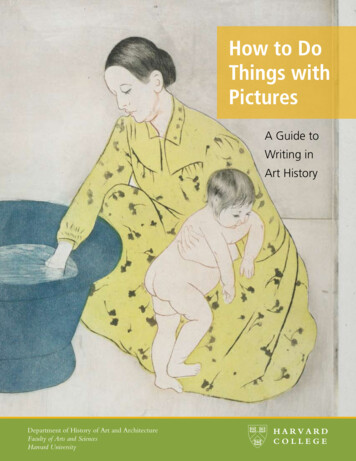
Transcription
How to DoThings withPicturesA Guide toWriting inArt HistoryDepartment of History of Art and ArchitectureFaculty of Arts and SciencesHarvard UniversityHARVARDCOLLEGE
How to Do Things with PicturesA Guide to Writing in Art Historyby Andrei Pop
Cover photo credit: Harvard News OfficeCopyright 2008, President and Fellows of Harvard College
Table of ContentsPlan of the book .1Looking1. Why write? . .32. Finding the object .63. Taking notes .74. Asking questions .85. Research . 10Intermezzo: What is Art? .15Writing6. The writer’s tools . 177. Outlining . . 228. Reorganizing . . 269. The writer’s space . 2710. Writing . . 27Finishing . 32Further Reading . 33Glossary . . 35
Plan of the BookThis book is intended as an introduction to writing about art. But many of the challenges encountered in first writing about art never go away, no matter how much practice we get. For this reason, the book might also be of interest to experienced writers.The basic trouble with writing about art, or even thinking about art for that matter, isthat we have to employ words to describe, explain, evoke, or otherwise circumnavigatesensory experience: visual, auditory, tactile, gustatory and even, god forbid, olfactory.This is a problem in part because the senses are still somewhat embarrassing to us asintellectual beings (art writing is unintentionally personal), and in part because, thoughwe talk about things we see and hear every day, we so seldom consider how we seethings or the manner in which sound or feelings propagate in us. In short, we are forcedto remember and also to articulate processes which usually remain vague. The resultsare often intriguing, even pleasurable. But the learning curve can be off-putting.With this difficulty in mind, I have organized the book around two themes, looking and writing, with an intermezzo on the definition of art, and some addenda. Thetreatment of the first theme, looking, is meant to activate what many people considera passive operation. As such, purposeful looking includes much thinking, note-taking,and scholarly research—looking through books. The end result of this persistent gazeat the art object is that the writer should never be in the position of having to approachthe blank piece of paper (blank screen) with nothing to say. Writing, the second theme,represents the consolidation and communication of the viewer’s knowledge and thinking. The first four chapters are preparatory in nature and only the last (chapter 10) dealswith formal essay writing. The rationale for this arrangement is that scholarly writing isnot simple, but that its complexity and practical value stem from a systematic, patientapproach to organizing and presenting evidence, not from any rigid rules of content.All in all, the modest goal of this book is to make academic art writing painless andintellectually rewarding for the writer. Whether the end result of a subjectively happier writing experience will be a better essay remains to be seen—but it is a reasonableexpectation. If this happens, we might also get happier teachers.The basic trouble withwriting about art, or eventhinking about art for thatmatter, is that we have toemploy words to describe,explain, evoke, or otherwise circumnavigatesensory experience.Though not intended specifically as an introduction to writing art history, this bookis written from the perspective of an art historian. This is in part a limitation of the author; readers might find a philosopher’s or a poet’s take more enlightening. Art historyindeed is a relatively young discipline. But it has stumbled across more of the obstaclesencountered in thinking about art than just about any other academic discipline. Someof the obstacles will resurface here, with appropriate signposts.How-to books often suffer from too stuffy or too familiar a style, regaling the readerwith what “one,” or “you,” should do. Analogously, they often flit between advice thatis too general and a schoolmasterly dogmatism. While this book runs into both faults, Ihave tried to address the second by giving very specific advice that the reader is free notto follow, according to her own taste and intellectual preferences.A Guide to Writing in Art History page 1
Fig.1 Mary Cassatt, The Bath, 1890-1891, drypoint, softground etching, and aquatint.page 2 Part One: Looking
Part One: LookingWhy Write?“Alright,” replies the harried student, “the paper is not due for another week. Whatis the philosophical purpose of writing about art?” Again, the question should be mademore specific: “what is my purpose?” Even this may be to some degree handed down bythe professor (cigar-puffing editor) in the form of a prompt. Still, there is no way writing will take place until the task is personalized to the point where one’s own intellecttakes over. We’ll return to the problem of the assignments later, since that is a problemof interpretation. Let us assume for the moment a writer free to write anything aboutany artwork (for simplicity we start with one piece). Say you’ve chosen The Bath, a latenineteenth-century print by Mary Cassatt (Fig.1). Examine the work for a moment,allowing its rich, overwhelming peculiarity to sink in. Stare at some detail until you’velost track of the big picture. Pause and glance out the window.Now return to those starting questions: what to write about, and for whom? Thesubject seems to be stare one in the face. Yet in the compactness of even a deceptivelysimple print there are a thousand thematic threads one can unravel. Shall I write aboutthe artist’s handling, the way she simulates the informality of an afternoon bath? ShouldI wax lyrical on the mother-child bond? Or might I explore an ambivalence suggestedby the physical distance between woman and child, and the latter’s puppet-like motion?part oneBefore we can begin a discussion of how to write about art, the crucial question iswhy? There is a reductive answer to this: “because it’s assigned,” or “because it mightas well be.” Not only is this answer banal, but it is unhelpful because it cannot inspireus to generate prose. The harried student facing an impending and arbitrary assignmentshould imagine himself in the place of a harried staff writer on a newspaper. “Why amI writing about art?” implies not only the question “what am I writing about?”, but“what is new and interesting about what I am writing?” and “to whom is it new andinteresting?”One should daydream subjects in this way, staying alert for an idea that is particularly just (“it fits”) or that excites one’s curiosity or store of acquired knowledge (“Iknow this well”). But how to decide, finally, what to write about? Is this an irrationalmatter? Yes and no. Even on a deadline, what one actually writes always emerges fromodd, unexamined impulses. You don’t have time to analyze yourself. Yet one can gainsome control over this whimsical process—even force ideas when the imagination isunwilling—simply to juxtaposing the question “what to write about?” with the corollaries we’ve already discussed, particularly “who am I writing for?” and the selfish “whatam I interested in?” This latter question must be interpreted broadly: one can writewell about the familiar, but sheer excitement of discovery can carry one into unknownwaters, and produce a better text to boot. As for “who am I writing for?” this is theperennial question for writers, the question of the audience. Student writers tend tobe cynical about this, citing an “audience of one,” their instructor. This should ratherencourage them! Where the professional writer struggles with a nebulous public ofwidely varying skills and interests, the student has one attentive, well-informed reader.A Guide to Writing in Art History page 3
The question then is: what can I tell my reader? An unambitious writer tells the readerwhat she already knows. This is flattering, and if the reader is undemanding, the writerwill get away with it.A better writer will try to leverage what the reader already knows, establishing aconnection with something she doesn’t know—or doesn’t know that she knows. Whatdo you know that no-one else knows? With pictures this question is hardly daunting,since every inexperienced writer can discover something radically new through simplylooking (or hearing, touch, etc., if the art object is not primarily visual). Writing aboutthis sensory encounter is neither an outdated ritual from the pre-jpeg era, nor an end initself. It not only establishes the writer’s grasp of the object, but digests that object intointelligible ideas about the world that she shares with the reader. Whether the readerhas his own prior experiences of the art object or not, after reading, she should possessan experience of the writer’s encounter with that object.Let us return to The Bath. As with most visual objects, we can crudely distinguishtwo distinct but overlapping aspects of the work, its physical substance (the paper,ink, draftsmanship, arrangement of colored shapes; what is sensible in the image) andits conceptual content (the narrative situation, its emotional and intellectual implications, its cultural presuppositions). One cannot always make this separation neatly (forinstance, see Fig.2), but here it allows us to discern two broadly opposed approachesto art writing that will probably never be entirely reconciled. On the one hand, we’redealing with a formalist approach, which delves into the mechanics of visual or othersensory representation to address the way the image works, excluding as extrinsic circumstances outside the work, from the biography to the culture of the maker. On theother hand we have a contextual approach, which reads through the images social orcultural processes that played a role in the artist’s milieu, and often continue to do so inthe present. These two types of art writing are often combined by intelligent writers,but not without difficulties, because they tend to produce divergent results. The formal argument tends to insist on the uniqueness of the art object, on its specificity. Thecontextual argument on the contrary sees the same kind of forces informing the art andthought of a period, its visual objects and its social life.It is not difficult, even without practice, to produce insights of the two types aboutThe Bath. The assured sketchiness of the drypoint technique; the anatomical truthfulness, to the point of awkwardness, of the bodies, the cool, flattening harmony of blueand yellow regions—all these point to formal qualities that belong uniquely to this image. As a writer, the formalist celebrates this specificity, or perhaps recounts it in a toneof cool objectivity. Yet are these particularities ultimately as significant as the body ofsocial convention that envelops the image like a fuzzy blanket? The casual, almost compulsory bond between mother and child, dramatized by the artist, is a central tenet ofmodern European ideologies of the nuclear family. The contextualist may expose thiscollaboration between art and society in a critical tone. Or she might draw attentionto the subjective primacy of the viewer, who is given an imaginative opportunity tointerpret the relationship between the two figures. The writer may find this particularcoincidence between art and culture liberating, or confining.Are formal and contextual insights incompatible? Are they as incompatible as, say, apositive and a negative reading? Probably not. A nuanced view of the past is one that isaware both of how it resembles and how it differs from the present. Likewise, art objectsboth resemble and differ from the artists and the societies that produced them—andfrom each other. In Cassatt’s case, one could argue that the combination of a Victorianpage 4 Part One: Looking
sentimental subject with an unfamiliar perspective (reminiscent of Japanese prints) andcolor scheme serves to de-familiarize motherhood, to render it a strange and imaginatively charged activity. This is only a hunch, and we want to test it thoroughly: forinstance, by asking whether our argument still makes sense if the woman administeringthe bath is not the mother, but a governess or wet-nurse. But insofar as we have foundboth something strange and something generic about the image, we have the historicaltraction needed to turn our hunch into a well-arguable thesis.Having examined two divergent strategies of art writing, and a proto-thesis thatcombines the two, we can suggest how art historians reach their argumentative goals.Art writing does not propose to establish universal principles. A thesis in art history iscontingent on the objects it is applied to: truth depends on fit. This is because art itself isa slippery mixture of culture and physical nature. What one can do in a successful pieceof art prose is to suggest strongly. A strongly suggestive idea is far from useless: its valueis proven over time, as other writers and readers rely upon it to make sense of this artobject, and perhaps others. Ideas in art history, then, are only as good as the objects theyare applied to. That is, they are right insofar as they explain visible things.In the case of the Cassatt print, one has the fortune of a generously sensual objectto tackle. But what if the art remains mute, if it simply refuses to volunteer a narrativecontent? One can still find a story to tell, by reflection on the sort of text one wishesto write. For although good art writing gives some account of sensory matter, it cannot stop there. Art objects, for all their power of immediacy, are made by specificindividuals working in distinct places and times. Thus any full account of them mustto some degree be historical. Depending on the writer, the text may reach down intophilosophical conclusions, or press ahead with social scientific, political, even moralconsiderations. Though it is unfashionable at the moment, one may even insist on theaesthetic force of an object divorced from any notion of utility. These are not end results, but only starting frames of mind. But finding a compelling object comes first.Ideas in art history, then,are only as good as theobjects they are applied to.That is, they are right insofar as they explain visiblethings.A Guide to Writing in Art History page 5
Finding the ObjectThis section was once called “Encountering the Object” until I realized that thereal difficulty lies in finding the object. As a teacher, I’ve seen many a decent paperthat might have been great had the student found a subject that truly excited her. Thisunfortunately is also true of many books written by professionals. For this reason, thetime spent strolling around museum or flipping through exhibition catalogues prior towriting is time well spent. Here, prior knowledge can often be misleading. As a student,I myself have been stuck writing on hopeless subjects simply out of a complacent beliefthat I liked the artist in question. Artists, like all creative people, are inconsistent. Makesure you know the work itself before making up your mind to work on it.Is it important to like what you write about? Yes, because without sympathy, youwill be missing the curiosity that is a crucial ingredient to good thinking. What if onehas been assigned an antipathetic artwork? Then the writer should at least try to workup genuine indignation against the piece: for this will equip one with some of the sameresourcefulness as enjoying the work. The only warning about writing from a deeplycritical standpoint is that one should beware of being closed-minded on the subject.One should rather maintain the aplomb of a detective who is willing to discover exonerating evidence—and not suppress it.Let us call this metaphorical stand-in for the writer Sherlock Holmes. Holmes isobservant, sharp, and methodical. But that isn’t enough. If you’ve read Arthur ConanDoyle you know that the stories wouldn’t be interesting without Watson, the excitablecompanion of Holmes who asks all the naïve questions. The writer’s psyche shouldlikewise make room for this asker of questions. One must be curious, willing to beshocked, and indeed to allow oneself to be drawn to precisely that which is shockingand vital. This will generate the problems for the Sherlock Holmes mentality to solve.So, we are going to go to the museum looking for a mystery. Which museum?Whichever art museum is closest to one, or collects objects of particular personal interest. Locations and schedules can be discovered online. No museum handy? A searchof one’s library or of the website of a reputable institution (the Louvre in Paris, theMetropolitan Museum in New York, the Kunsthistorisches Museum in Vienna, etc.)will provide one with an embarrassment of riches for the analyst. Let us see how theselection process works in a live museum setting.For the Harvard student, the museums of choice for an immediate stroll will be theFogg or the Sackler. For argument’s sake, let us say we have chosen the Fogg. Makesure to bring relevant ID, as well as a pencil for note-taking (pens are never allowed inmuseum galleries). Once inside, there is a chance to orient oneself. The Fogg’s courtyard replicates an Italian villa, which means that through the upper-story windows youwill catch glimpses of the art contained therein. Like many teaching museums, the Foggis arranged chronologically. The oldest art (medieval and Renaissance) is on the groundfloor, with more recent art arranged clockwise around the courtyard on the secondfloor. Though the art on display changes occasionally—the permanent collection being several orders of magnitude higher than the available space—like most museums,works are arranged in part according to rather old and confused ideas about what ismost prestigious or worth seeing. The least respected objects (though by no means theleast interesting) occupy stairwells. There is a room on the ground floor for changing,often thematic exhibitions. There is also a museum shop where one can find books onsome of the relevant art—but at this point in the visit it is the original objects whichinterest us.page 6 Part One: Looking
As one walks around it is worth jotting down names and dates of interesting worksand artists. Dates are always worth writing down, because one forgets them easily, andbecause they compress so much useful knowledge about the historical matrix of a workof art. What interests one is one’s own business; one should always be selfish in thisrespect instead of trying to work up enthusiasm for someone else’s ‘great’ artists.In my case, I am fascinated by a violently painted portrait of a woman, or ratherof her head and shoulders, looming out of a smallish canvas. The sitter is Emma Hart,painted by the Englishman George Romney. Neither name is particularly resonant, butthe object is arresting. There is something extreme about it, which makes the othernearby portraits seem less vibrant to me. This is a good sign. Sitting on a bench, I consider the artwork and its neighbors. This produces some doubt: there are a dozen interesting pictures in the room, some of which contain more obvious interpretive potentialthan my close-up portrait of an eighteenth-century woman. What to do?After a first stage of aesthetic gut reaction, many viewers experience a certain kind ofvertigo or gnawing uncertainty as to what an art object is about. This is a natural reaction, since images do not speak of themselves: it is part of the life of artworks to havestories drawn out of them by the viewer. And works which seem particularly opaqueor enigmatic tend to provide the most interesting challenge to the writer. Once onehas chosen a piece (or several) to write about, enough time should be spent in theirpresence to get quite familiar with the physical reality of the objects—and to allow theimagination to work on them, supplying the mind with a variety of wild hypotheses.Taking NotesBecause our memories are unreliable—or, to put it differently, because we havestrong imaginations—we humans take notes. Everyone has her own note-taking ritual,which is best left alone, but I will add some generalities in taking notes on art objects.Take notes on appearance. By this I mean anything in the picture, from objects andpeople represented to the degree of reflection and cracks in the paint and style of theframe; if the object is a sculpture, color, texture, and shape from every conceivableangle. Do this even if you are able to take a photograph or find one elsewhere; youwill be shocked by how much of this apparent information (from cracks and reflectanceto frames) is omitted in even a good textbook photo. And most photos of artworks areterrible. If you don’t have an opportunity to see the work of art in person, take noteson the best image you can find, or better yet on several. This might seem redundantif you’re working with a reproduction anyway, but the freshness of a first look is notto be underestimated. You will see more things later, but when you dig up your firstnotes, you will also be surprised to discover how much you saw the first time that youmissed later.When you dig up yourfirst notes, you will also besurprised to discover howmuch you saw the firsttime that you missed later.Conduct a formal analysis. In noting appearance, do not just state facts of vision, butanalyze them. That is, organize your perceptions to yield useful generalizations about thework in question (e.g. “there is a dark mass in the upper-left-hand corner and a lightmass diagonally across from in the lower-right”). Not only is this useful as shorthand(writing “pyramidal composition” is more concise than describing every object), butthe acute attention of the first look will prompt structural insights you’ll miss in a latenight writing session. This is especially true of work that doesn’t reproduce well: threedimensional sculpture, or, say, a contemporary art installation mixing sound and videoprojection. The spatial notes you take (“whispering sounds from rear wall, stock quotesA Guide to Writing in Art History page 7
projected at 45º angle from opposite corners”) will be far better and more explicit thanthe information contained in a murky catalogue photo.Jot down thoughts, ideas, sentiments. As you busy yourself with facts of sensation,unbidden thoughts will clamor for your attention. “Creepy effect of dripping paint” or“excitement of destruction” might not be thesis candidates, or even sentences you wantto introduce undigested into a finished essay, but they do contain a lot of informationabout the artwork and the way it affects its viewer, you in this case. They will be usefullater, when the first emotional and intellectual associations provoked by the work haveworn off, or have given way to different ones.Of course, there is no reason to separate notes of the above three types, all of whichhave to do with articulating sensory information and the ideas it generates. But it mightbe useful, in a separate and clearly marked space, to write down the wall label information: artist name, date, and title, and whatever else is given. Does the art piece belongto someone beside the museum which is presently showing it? What are its exact dimensions? You may now think that the exact size is a silly formality, but you won’tbe able hold your hands out to estimate size when you’re writing the paper. Do thecurators provide interpretation as well, in the form of a paragraph or two about thework? Such texts are often uninteresting, having been trimmed for easy consumption,but they are the product of an immense amount of research on the part of curators andtheir assistants, so they do sometimes contain information that is of great interest to theresearcher, or that will help you make some immediate sense of the piece. These textsare sometimes reproduced online or in catalogues, but most often not.Asking QuestionsAt this point in the game, things are going well. If one has been particularly timelyin staking out the territory—choosing a work, thinking up preliminary ideas—this isthe point where laziness or boredom threatens. It may seem that there is much youcannot yet know (“the exact meaning of the work”), or simply that there is “nothingmore to be done” until you sit down and write the essay, or go to the library and dosome research.The problem with this mood is that it causes one to neglect going to the library (orsitting down to write) for weeks, by which time one’s excitement and inquisitivenesshave been considerably blunted. There is no simple solution for the subjective ups anddowns of writing, but there is a way to deny oneself excuses, particularly the one about“not knowing things, but I can look them up later.”The solution here is simply to ask questions. These questions cannot serve as an easyway out of doing one’s own research. (If you do get ideas from other people that youabsolutely have to use, you must cite them as the source of information—even if youlater find the same information in a printed source). What asking questions can accomplish, however, is to stimulate one’s own curiosity about the work, open up unexpectedways to look at an object, or convince one that an object is genuinely interesting andin need of explication.Museum people. One can make an appointment to discuss a work with a curator oran assistant. Unless the person in question is terribly busy (or unfriendly), they will usually have something pertinent to say; they also tend to have, in their files, crucial andotherwise difficult to find information about the work, from newspaper clippings tosales documents. Museum people tend to be sober and intelligent, so they are not usu-page 8 Part One: Looking
ally a good audience for one’s wildest theories about a work. Ask them instead concretequestions about a work’s provenance, technique, and about the artist in question.Whom else besides curators should one speak to in a museum? One is surroundedby visitors—those worth talking to are the ones interested in the same work as oneself.People are unused to talking in museums, which makes it all the more appealing—butdon’t yell. Tour guides occasionally plow by with their captive audiences. Here, ofcourse, one does not want to intrude, but it pays to do some overhearing. And museumguards, provided they are not overworked shepherding a roomful of school kids, canbe insightful. Some of them are artists, and in any case they have looked at the work ondisplay longer than yourself and the curator combined.Librarians. If you are seeking facts, or trying to work through a problem of interpretation yourself, the help you need is usually found in books. We will deal with booksin great detail in the next chapter. But books do not exist in a vacuum. Whether or notyou have access to a specialized art library (Harvard’s Fine Arts Library is one of the bestin the world), a reference librarian can point you to the right kind of books, even tobooks you may have hoped didn’t exist. They can also help you fine-tune a computersearch so that it will yield a manageable list of books instead of 0 or 1000. And, besides,librarians read books. They may know just what you need.Teachers. Speaking of people who read books, the student will invariably turn toteachers, particularly the professor or teaching fellow who assigned the paper. There areexcellent students who visit office hours weekly, and others who won’t set foot in aninstructor’s office. This is a matter of personality. Either way it is important to do one’sown thinking, as independently as possible from the competence of the teacher—afterall, you’re working towards a similar competence.For questions that seem embarrassingly easy, or speculative, or when one just doesn’tknow how to start, no-one is as generous in entertaining far-fetched hypotheses asone’s friends and peers (and why not, family). At the very least, you won’t be sufferingin their presence from any of the self-consciousness or performance anxiety felt in thevicinity of the teacher. This is crucial, because the point of asking questions is not toclose the matter once and for all, but to get started formulating one’s own answer.There will be readers who have turned the last few pages with suspicion, and are nowready to skip to the next chapter in outrage. “Ask my mother? That would be the blindleading the blind!” First of all, your mother deserves better. Secondly, I know the feeling. I have written whole essays where, if the physical paper had gotten lost, no witnesscould be found to vouch for their existence. But this is a shame, not only because a socially produced essay is more enjoyable to write, but because the whol
A Guide to Writing in Art History page 1 The basic trouble with writing about art, or even thinking about art for that matter, is that we have to employ words to describe, explain, evoke, or other-wise circumnavigate sensory experience. Plan of the Book This book is intended as an introduction to











